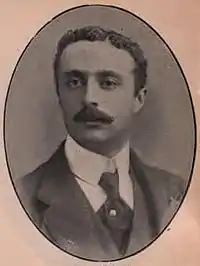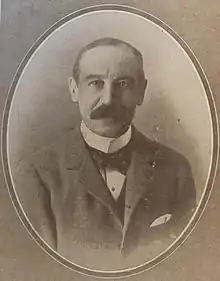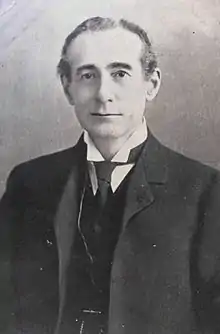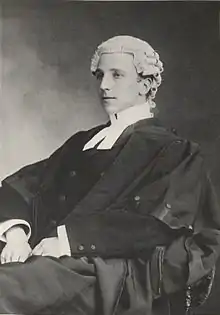Crewe (UK Parliament constituency)
Crewe was a constituency of the House of Commons of the Parliament of the United Kingdom from 1885 to 1983. It elected one Member of Parliament (MP) by the first past the post system of election.
| Crewe | |
|---|---|
| Former County constituency for the House of Commons | |
 Boundary of Crewe in Cheshire, boundaries 1974-83 | |
| County | Cheshire |
| 1885–1983 | |
| Seats | One |
| Created from | Mid Cheshire and West Cheshire |
| Replaced by | Crewe & Nantwich and Congleton |
History
Crewe was first created as one of eight single-member divisions of Cheshire under the Redistribution of Seats Act 1885. As its name suggested, the constituency was centred on the town of Crewe in Cheshire. The town of Nantwich was also included in the constituency until 1955, when it gained its own eponymous seat.
It was abolished following the reorganisation of local authorities in 1974 by the Third Periodic Review of Westminster constituencies for the 1983 general election, when it was divided roughly equally between the new constituencies of Crewe and Nantwich, and Congleton.
Boundaries
1885–1918: The Municipal Borough of Crewe, and parts of the Sessional Divisions of Nantwich and Northwich.[1]
Included the parishes of Alsager, Haslington, Nantwich and Sandbach.
1918–1950: The Municipal Borough of Crewe, the Urban Districts of Alsager and Nantwich, and parts of the Rural Districts of Congleton and Nantwich.[2]
Sandbach transferred to Northwich.
1950–1955: The Municipal Borough of Crewe, the Urban District of Nantwich, and the Rural District of Nantwich.[3]
Gained the remainder of the Rural District of Nantwich, including Audlem, from the abolished constituency of Eddisbury. Sandbach and the part of the Rural District of Congleton transferred to Knutsford.
1955–1983: The Municipal Borough of Crewe, the Urban Districts of Alsager and Sandbach, and in the Rural District of Nantwich the civil parishes of Barthomley, Crewe, Haslington, and Weston.[3]
Gained Alsager and Sandbach back from Knutsford. The Urban District and the bulk of the Rural District of Nantwich transferred to the new constituency of Nantwich.
From 1 April 1974 until the constituency was abolished at the next boundary review which came into effect for the 1983 general election, the constituency comprised parts of the newly formed Boroughs of Congleton, and Crewe and Nantwich, but its boundaries were unchanged.
On abolition, the part comprising the former Municipal Borough of Crewe was included in the new constituency of Crewe and Nantwich, with Alsager, Haslington and Sandbach was added to the new constituency of Congleton.
Members of Parliament
Elections
Elections in the 1880s
| Party | Candidate | Votes | % | ±% | |
|---|---|---|---|---|---|
| Liberal | George William Latham | 5,089 | 54.3 | ||
| Conservative | Oscar Leslie Stephen | 4,281 | 45.7 | ||
| Majority | 808 | 8.6 | |||
| Turnout | 9,370 | 86.6 | |||
| Registered electors | 10,815 | ||||
| Liberal win (new seat) | |||||
| Party | Candidate | Votes | % | ±% | |
|---|---|---|---|---|---|
| Liberal | Walter McLaren | 4,690 | 53.7 | -0.6 | |
| Conservative | Francis Randle Twemlow[6] | 4,045 | 46.3 | +0.6 | |
| Majority | 645 | 7.4 | -1.2 | ||
| Turnout | 8,735 | 80.8 | −5.8 | ||
| Registered electors | 10,815 | ||||
| Liberal hold | Swing | -0.6 | |||
Elections in the 1890s
| Party | Candidate | Votes | % | ±% | |
|---|---|---|---|---|---|
| Liberal | Walter McLaren | 5,558 | 58.2 | +4.5 | |
| Conservative | Horace W Chatterton[7] | 3,990 | 41.8 | -4.5 | |
| Majority | 1,568 | 16.4 | +9.0 | ||
| Turnout | 9,548 | 83.7 | +2.9 | ||
| Registered electors | 11,412 | ||||
| Liberal hold | Swing | +4.5 | |||

| Party | Candidate | Votes | % | ±% | |
|---|---|---|---|---|---|
| Conservative | Robert Ward | 5,413 | 52.7 | +10.9 | |
| Liberal | Walter McLaren | 4,863 | 47.3 | -10.9 | |
| Majority | 550 | 5.4 | N/A | ||
| Turnout | 10,276 | 85.5 | +1.8 | ||
| Registered electors | 12,018 | ||||
| Conservative gain from Liberal | Swing | +10.9 | |||
Elections in the 1900s

| Party | Candidate | Votes | % | ±% | |
|---|---|---|---|---|---|
| Liberal | James Tomkinson | 6,120 | 55.4 | +8.1 | |
| Conservative | J E Reiss | 4,921 | 44.6 | -8.1 | |
| Majority | 1,199 | 10.8 | N/A | ||
| Turnout | 11,041 | 82.1 | −3.4 | ||
| Registered electors | 13,447 | ||||
| Liberal gain from Conservative | Swing | +8.1 | |||
| Party | Candidate | Votes | % | ±% | |
|---|---|---|---|---|---|
| Liberal | James Tomkinson | 7,805 | 59.6 | +4.2 | |
| Conservative | James Hugh Welsford | 5,297 | 40.4 | -4.2 | |
| Majority | 2,508 | 19.2 | +8.4 | ||
| Turnout | 13,102 | 87.1 | +5.0 | ||
| Registered electors | 15,051 | ||||
| Liberal hold | Swing | +4.2 | |||
Elections in the 1910s
| Party | Candidate | Votes | % | ±% | |
|---|---|---|---|---|---|
| Liberal | James Tomkinson | 7,761 | 53.3 | -6.3 | |
| Conservative | John Lane Harrington | 5,419 | 37.2 | -3.2 | |
| Labour | Frank Rose | 1,380 | 9.5 | New | |
| Majority | 2,342 | 16.1 | -3.1 | ||
| Turnout | 14,560 | 91.8 | +4.7 | ||
| Registered electors | 15,866 | ||||
| Liberal hold | Swing | -1.6 | |||

| Party | Candidate | Votes | % | ±% | |
|---|---|---|---|---|---|
| Liberal | Walter McLaren | 7,639 | 55.8 | +2.5 | |
| Conservative | James Hugh Welsford | 6,041 | 44.2 | +7.0 | |
| Majority | 1,598 | 11.6 | -4.5 | ||
| Turnout | 13,680 | 86.2 | −5.6 | ||
| Registered electors | 15,866 | ||||
| Liberal hold | Swing | -2.3 | |||
| Party | Candidate | Votes | % | ±% | |
|---|---|---|---|---|---|
| Liberal | Walter McLaren | 7,629 | 56.3 | +3.0 | |
| Conservative | Ernest Craig | 5,925 | 43.7 | +6.5 | |
| Majority | 1,704 | 12.6 | −3.5 | ||
| Turnout | 13,554 | 85.4 | −6.4 | ||
| Liberal hold | Swing | −1.8 | |||
| Party | Candidate | Votes | % | ±% | |
|---|---|---|---|---|---|
| Unionist | Ernest Craig | 6,260 | 44.6 | +0.9 | |
| Liberal | Harold Lawson Murphy | 5,294 | 37.7 | −18.6 | |
| Labour | James Holmes | 2,485 | 17.7 | New | |
| Majority | 966 | 6.9 | N/A | ||
| Turnout | 14,039 | 88.1 | +2.7 | ||
| Registered electors | 15,927 | ||||
| Unionist gain from Liberal | Swing | +9.8 | |||
General Election 1914–15:
Another General Election was required to take place before the end of 1915. The political parties had been making preparations for an election to take place and by the July 1914, the following candidates had been selected;
- Unionist: Ernest Craig
- Liberal: Joseph Davies

| Party | Candidate | Votes | % | ±% | |
|---|---|---|---|---|---|
| C | Liberal | Joseph Davies | 13,392 | 56.2 | −0.1 |
| Labour | James Brownlie | 10,439 | 43.8 | N/A | |
| Majority | 2,953 | 12.4 | −0.2 | ||
| Turnout | 23,831 | 68.4 | −17.0 | ||
| Registered electors | 34,818 | ||||
| Liberal hold | Swing | N/A | |||
| C indicates candidate endorsed by the coalition government. | |||||
Elections in the 1920s

| Party | Candidate | Votes | % | ±% | |
|---|---|---|---|---|---|
| Labour | Edward Hemmerde | 15,311 | 50.9 | +7.1 | |
| National Liberal | Joseph Davies | 14,756 | 49.1 | −7.1 | |
| Majority | 555 | 1.8 | N/A | ||
| Turnout | 30,067 | 80.9 | +12.5 | ||
| Registered electors | 37,159 | ||||
| Labour gain from Liberal | Swing | +7.1 | |||

| Party | Candidate | Votes | % | ±% | |
|---|---|---|---|---|---|
| Labour | Edward Hemmerde | 14,628 | 46.5 | −4.4 | |
| Unionist | Thomas Strangman | 8,734 | 27.8 | New | |
| Liberal | Robert Mortimer Montgomery | 8,068 | 25.7 | −23.4 | |
| Majority | 5,894 | 18.7 | +16.9 | ||
| Turnout | 31,430 | 82.8 | +1.9 | ||
| Registered electors | 37,959 | ||||
| Labour hold | Swing | +9.5 | |||
| Party | Candidate | Votes | % | ±% | |
|---|---|---|---|---|---|
| Unionist | Ernest Craig | 18,333 | 55.5 | +27.7 | |
| Labour | Edward Hemmerde | 14,705 | 44.5 | −2.0 | |
| Majority | 3,628 | 11.0 | N/A | ||
| Turnout | 33,038 | 85.6 | +2.8 | ||
| Registered electors | 38,583 | ||||
| Unionist gain from Labour | Swing | +14.9 | |||
- Liberal candidate, Alexander Lyle-Samuel withdrew.
| Party | Candidate | Votes | % | ±% | |
|---|---|---|---|---|---|
| Labour | William Bowen | 20,948 | 50.2 | +5.7 | |
| Unionist | Donald Somervell | 11,732 | 28.1 | −27.4 | |
| Liberal | William Craven Llewelyn | 9,076 | 21.7 | New | |
| Majority | 9,216 | 22.1 | N/A | ||
| Turnout | 41,756 | 83.7 | −1.9 | ||
| Registered electors | 49,863 | ||||
| Labour gain from Unionist | Swing | +16.6 | |||
Elections in the 1930s
| Party | Candidate | Votes | % | ±% | |
|---|---|---|---|---|---|
| Conservative | Donald Somervell | 25,141 | 57.8 | +29.7 | |
| Labour | William Bowen | 18,351 | 42.2 | -8.0 | |
| Majority | 6,790 | 15.6 | -6.5 | ||
| Turnout | 43,492 | 84.5 | +0.8 | ||
| Conservative gain from Labour | Swing | ||||
| Party | Candidate | Votes | % | ±% | |
|---|---|---|---|---|---|
| Conservative | Donald Somervell | 21,729 | 51.3 | -6.5 | |
| Labour | William Bowen | 20,620 | 48.7 | +6.5 | |
| Majority | 1,109 | 2.6 | -13.0 | ||
| Turnout | 42,349 | 80.3 | -4.2 | ||
| Conservative hold | Swing | ||||
General Election 1939–40
Another General Election was required to take place before the end of 1940. The political parties had been making preparations for an election to take place and by the Autumn of 1939, the following candidates had been selected;
- Conservative: Donald Somervell
- Labour: William Bowen[9]
Elections in the 1940s
| Party | Candidate | Votes | % | ±% | |
|---|---|---|---|---|---|
| Labour | Scholefield Allen | 28,416 | 60.6 | +11.9 | |
| Conservative | Donald Somervell | 18,468 | 39.4 | -11.9 | |
| Majority | 9,948 | 21.2 | N/A | ||
| Turnout | 46,884 | 74.6 | -5.7 | ||
| Labour gain from Conservative | Swing | ||||
Elections in the 1950s
| Party | Candidate | Votes | % | ±% | |
|---|---|---|---|---|---|
| Labour | Scholefield Allen | 28,981 | 53.3 | -7.3 | |
| Conservative | John Richard T. Turner | 25,355 | 46.7 | +7.3 | |
| Majority | 3,626 | 6.6 | -14.4 | ||
| Turnout | 54,336 | 86.7 | +12.1 | ||
| Labour hold | Swing | ||||
| Party | Candidate | Votes | % | ±% | |
|---|---|---|---|---|---|
| Labour | Scholefield Allen | 28,488 | 52.2 | -1.1 | |
| Conservative | John Richard T. Turner | 26,045 | 47.8 | +1.1 | |
| Majority | 2,443 | 4.6 | -2.0 | ||
| Turnout | 54,533 | 86.6 | -0.1 | ||
| Labour hold | Swing | ||||
| Party | Candidate | Votes | % | ±% | |
|---|---|---|---|---|---|
| Labour | Scholefield Allen | 21,629 | 52.5 | +0.3 | |
| Conservative | Granger Farwell Boston | 15,273 | 37.1 | -10.7 | |
| Liberal | Thomas Stuttard Rothwell | 4,306 | 10.5 | New | |
| Majority | 6,356 | 15.4 | +10.8 | ||
| Turnout | 41,208 | 81.5 | -5.1 | ||
| Labour hold | Swing | ||||
| Party | Candidate | Votes | % | ±% | |
|---|---|---|---|---|---|
| Labour | Scholefield Allen | 22,811 | 54.5 | +2.0 | |
| Conservative | Geoffrey Leonard Beaman | 19,030 | 45.5 | +8.4 | |
| Majority | 3,781 | 9.0 | -6.4 | ||
| Turnout | 41,841 | 82.1 | +0.6 | ||
| Labour hold | Swing | ||||
Elections in the 1960s
| Party | Candidate | Votes | % | ±% | |
|---|---|---|---|---|---|
| Labour | Scholefield Allen | 23,579 | 57.2 | +2.7 | |
| Conservative | Anthony G. Barbour | 17,657 | 42.8 | -2.7 | |
| Majority | 5,922 | 14.4 | +5.4 | ||
| Turnout | 41,236 | 79.0 | -3.1 | ||
| Labour hold | Swing | ||||
| Party | Candidate | Votes | % | ±% | |
|---|---|---|---|---|---|
| Labour | Scholefield Allen | 24,141 | 61.0 | +3.8 | |
| Conservative | Anthony G. Barbour | 15,430 | 39.0 | -3.8 | |
| Majority | 8,711 | 22.0 | +7.6 | ||
| Turnout | 39,571 | 75.6 | -3.4 | ||
| Labour hold | Swing | ||||
Elections in the 1970s
| Party | Candidate | Votes | % | ±% | |
|---|---|---|---|---|---|
| Labour | Scholefield Allen | 22,160 | 54.3 | -6.7 | |
| Conservative | Alastair Goodlad | 18,678 | 45.7 | +6.7 | |
| Majority | 3,482 | 8.6 | -13.4 | ||
| Turnout | 40,838 | 71.0 | -4.6 | ||
| Labour hold | Swing | ||||
| Party | Candidate | Votes | % | ±% | |
|---|---|---|---|---|---|
| Labour | Gwyneth Dunwoody | 21,259 | 46.5 | -7.8 | |
| Conservative | James Graham Park | 16,136 | 35.3 | -10.4 | |
| Liberal | D. J. Hulland | 8,313 | 18.2 | New | |
| Majority | 5,123 | 11.2 | +2.6 | ||
| Turnout | 45,708 | 77.8 | +6.8 | ||
| Labour hold | Swing | ||||
| Party | Candidate | Votes | % | ±% | |
|---|---|---|---|---|---|
| Labour | Gwyneth Dunwoody | 21,534 | 49.7 | +3.2 | |
| Conservative | James Graham Park | 14,279 | 32.9 | -2.4 | |
| Liberal | E.A. Richardson | 7,559 | 17.4 | -0.8 | |
| Majority | 7,255 | 16.8 | +5.6 | ||
| Turnout | 43,372 | 73.2 | -4.6 | ||
| Labour hold | Swing | ||||
| Party | Candidate | Votes | % | ±% | |
|---|---|---|---|---|---|
| Labour | Gwyneth Dunwoody | 22,288 | 48.3 | -1.4 | |
| Conservative | J. V. Butcher | 18,051 | 39.1 | +6.2 | |
| Liberal | C. Bithell | 5,430 | 11.8 | -5.6 | |
| National Front | W. Tonks | 352 | 0.8 | New | |
| Majority | 4,237 | 9.2 | -7.6 | ||
| Turnout | 46,121 | 77.5 | +4.5 | ||
| Labour hold | Swing | ||||
References
- Great Britain, Incorporated Council of Law Reporting for England and Wales. The public general acts. unknown library. Proprietors of the Law Journal Reports, 1884.
- Fraser, Hugh (1918). The Representation of the people act, 1918 : with explanatory notes. University of California Libraries. London : Sweet and Maxwell.
- Craig, Fred W. S. (1972). Boundaries of parliamentary constituencies 1885-1972. Chichester: Political Reference Publications. ISBN 0-900178-09-4. OCLC 539011.
- British parliamentary election results, 1885–1918 (Craig)
- Debrett's House of Commons & Judicial Bench, 1886
- "Crewe". Cheshire Observer. 17 July 1886. p. 7. Retrieved 25 November 2017 – via British Newspaper Archive.
- "Saffron Walden". Herts & Cambs Reporter, and Royston Crow. 4 April 1890. p. 8. Retrieved 21 November 2017.
- British Parliamentary Election Results 1918–1949, FWS Craig
- Report of the Annual Conference of the Labour Party, 1939
- UK General Election results July 1945
- UK General Election results February 1950
- UK General Election results October 1951
- UK General Election results May 1955
- UK General Election results October 1959
- UK General Election results October 1964
- UK General Election results March 1966
- UK General Election results 1970
- UK General Election results February 1974
- UK General Election results October 1974
- UK General Election results May 1979